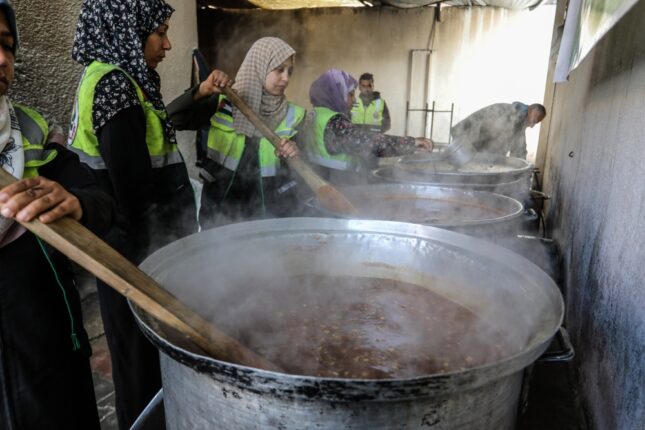-
Planning for Women in a Postwar Gaza
May 15, 2024 By Faria Nasruddin
International organizations and media stories have showcased how civilian women and children have been the primary victims of the Israeli campaign to eliminate Hamas in Gaza in the last seven months. Yet, the focus has been on exactly that—women and children as victims of violence. Little thought has been given to what happens to Palestinian women and children in Gaza once the guns are silenced and it comes time not only to reckon with the unimaginable violence and hardship endured during the war but to rebuild their lives and communities.
The grim reality in Gaza is that society has fundamentally changed as a result of this Israel-Hamas War. As of this writing, more than 10,000 women have been recorded as killed, more than 3,000 women now lead their households, 155,000 women are currently pregnant and will give birth amid a collapsed healthcare system, and nearly one million women and children are forcibly displaced.
At the most basic level, questions about what the future Palestinian society in Gaza will look like arise. Before October 7, children under the age of 18 comprised nearly half the population of Gaza. Now, who will make up Palestinian society? Who will be the political actors, economic units, and social leaders considering the surge in orphans, widows, and female-headed households?
While questions regarding the accuracy of data on the number of deaths of women and children have arisen and been politically leveraged in the information war, the ill-effects of this non-stop violence are undeniable: 93% of women in Gaza interviewed by UN Women said they felt unsafe, 80% suffered from feelings of depression, 66% were unable to sleep, and 70% suffered from anxiety and nightmares.
Throughout the war, women have had to become agents of survival, from former restaurant owners scraping together food for thousands of displaced families to mothers foregoing food to feed their children or to avoid having to use the facilities. The necessity of survival has propelled women into essential leadership and caretaking roles in their immediate communities.
A postwar plan that does not consider this reality—and make an active effort to include women’s voices, in line with UNSCR 1325 and UNSCR 1889—is one bound to fail Palestinian women in Gaza and sets a poor precedent for other conflicts globally. In the short term, it does not address women’s immediate needs, and in the long term, it does not consider what they will need to rebuild a society that prioritizes not only security but also opportunity and prosperity.
Lessons from the past
Much of the focus of the ‘day after’ in Gaza is on re-establishing physical security. Postwar plans by international policymakers focus on generating a new security architecture for Israel in Gaza, whether through an international military police force or private security firms. ‘Law and order’ within the Strip is seen as a prerequisite to the delivery of immediate humanitarian aid—and understandably so—to safeguard aid workers, begin physical reconstruction, and eventually transition power to a local entity. However, continued militarization and securitization has seldom turned out well for women in conflict or post-conflict arenas.
Before August 2021, when the United States was still present in Afghanistan and undertaking its ambitious national reconstruction plan, it deployed substantial military forces to re-establish physical security in the country, deter the Taliban, revitalize the economy, and establish a functional bureaucracy. Yet, reestablishing security after 2001 meant that the country continued to be the most dangerous place to be a woman in the world due to continued airstrikes and empowerment of local warlords with records of human rights abuses. Afghans in the diaspora, like Suraia Sahar state, “You cannot liberate women through occupation, through war, through violence, through bombs, through tanks.” Similar critiques can be made of plans for Gaza with militarized solutions.
Other postwar plans have a stronger emphasis on developing Gaza’s long-term economic capacity. These proposals acknowledge the high unemployment rates before October 7 and focus on private sector investment in large-scale projects like deep-water ports, soccer stadiums, and even a technical university.
While these plans are ripe with potential, gender backlash is a frequently documented feature of post-conflict societies. Reverting to a prior form of governance and economy often results in a regression of gender roles, where women are viewed solely as ‘caretakers’ and sidelined in a social and economic reconstruction that prioritizes the rehabilitation of men.
For instance, after the Sri Lankan Civil War ended in 2009, the disarmament, demobilization, and reintegration (DDR) campaign focused on reintegrating ex-combatants into essential industries like banking, real estate, transportation, and construction. A study done in the northern region of Vanni showed that there were more than 40,000 war widows struggling to make ends meet (in addition to the 30,000 female headed households in the east). Reconstruction efforts prioritized male-dominated industries, and these industries discriminated against women seeking jobs. Thus, women were left by the wayside.
If women remain marginalized in postwar planning, their chances for long-term social and economic recovery are slim. These conditions of acute vulnerability only increase the probability of enduring harm.
Generating opportunities & livelihoods
So, what would meaningful security for women entail? What does recovery look like for them? While certainly physical security is preferable to a state of anarchy, greater concern for how traditional security measures marginalize and, at times, harm women must be considered. Ending wartime violence means embarking on a broader project of re-establishing physical, economic, social, and psychological well-being.
New estimates indicate that it will take anywhere from 16 to 80 years and up to $40 billion to rebuild the physical infrastructure of Gaza. Rebuilding Gaza will be a multi-generational endeavor that will require both institutional investment and political will from Palestinians and the international community. When rebuilding begins, leaders mustn’t lose sight of what’s being rebuilt, why, and for whom. Centering on the people who have been most harmed—the women and children of Gaza—in a postwar reconstruction effort is vital.
Thus, part of this postwar plan must be the provision of social services and economic opportunities that will enable Palestinians, women in particular, to provide for themselves and their families. As shown by the postwar plans of the recent past, it is not enough to rebuild with ‘everyone’ in mind. At every stage, consultation and inclusion of Palestinian women is necessary, and gender audits must be conducted to ensure that their interests are at the fore not only in the first days after but also throughout the entire postwar period. Afterall, including women in peace processes increases the probability of a sustainable peace for all.
The views represented in this piece are those of the author and do not express the official position of the Wilson Center.
Faria Nasruddin is a Program Associate with the Wilson Center’s Middle East Program.
Sources: Associated Press, BBC News, The Christian Science Monitor, Daily Sabah, Foreign Policy Magazine, Human Rights Watch, Inter Press Service, International Feminist Journal of Politics, The Jerusalem Post, National Public Radio, The New Arab, The New York Times, Office of the Special Adviser on Gender, UN Women, United Nations Peacemaker, The Washington Post.
Photo Credit: Palestinian charitable organizations, with European support, distribute food “takiya” to displaced people in schools in the city of Rafah in the southern Gaza Strip. Anas-Mohammed/Shutterstock.com.
 A Publication of the Stimson Center.
A Publication of the Stimson Center.







